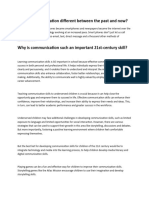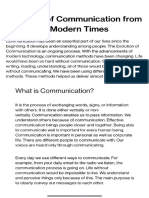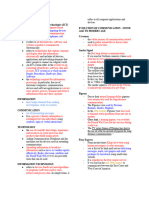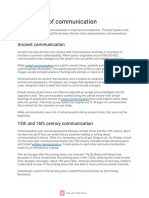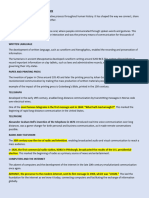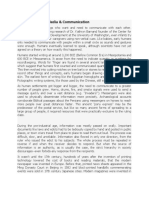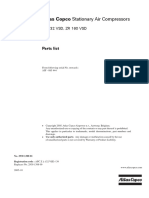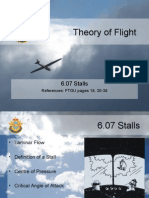Presented by prisha desai
1
� INTRODUCTION
The evolution of communication has changed a lot
since the start of communication in 100,000 BCE
with the origin of speech and it has not ended
.Since then, communication has evolved
tremendously, from spoken language to written
words, and even to instant messaging today.We
will see how inventions like the printing press, which
allowed information to spread more easily, and the
telephone, which let people talk across long
distances.
2
� COMMUNICATION
daily
newspaper WWW
(world wide
Cave web)
paintings
and
stone
carving twitter
television
broadcast
instant
messages
3
� cave painting and stone carvings
Before the invention of written language, prehistoric humans communicated
through cave paintings and petroglyphs. These early forms of communication,
dating back to as early as 40,000 years ago, served as a medium for storytelling,
recording events, and expressing religious and cultural beliefs.
The earliest known writing systems emerged around 3200 BCE in ancient
Mesopotamia and Egypt. Cuneiform, the script of ancient Sumer, marked the
beginning of recorded history, serving as a means to keep records of trade,
governance, and religious practices. Similarly, Egyptian hieroglyphics,
developed around 3200 BCE,
4
� carrier pigeons
The pigeon post was an early way of sending messages over long distances by
using trained homing pigeons. This was a reliable form of communication
before telephones or the internet.Pigeon posts were used in many parts of
history. In ancient Egypt and Rome, pigeons were used to send important
military messages. Later, during wars, like World War I and World War II,
soldiers relied on pigeons to send messages when other ways weren’t safe
5
� newspaper
The first known newspaper is usually considered to be the Acta Diurna from
ancient Rome. Around 59 BCE, the Romans used these "Daily Acts" to record
important information like government announcements, military news, and local
events. They were posted in public places so citizens could stay informed.In the
early 1600s, printed newspapers as we know them began to appear in Europe. One of
the first was called "Relation", in Strasbourg, Germany in 1605. It was filled with
news about politics and events in different parts of Europe, and people could
subscribe to receive it regularly.
6
� telegraph
The telegraph was one of the first major long-distance communication.
Invented in the early 1800s, the telegraph allowed people to send messages almost
instantly over long distances, a huge improvement over letters that took days
or weeks to arrive.The telegraph works by sending electrical signals through
wires. To send a message, a person used a device to tap out a code, called Morse
code Each letter of the alphabet was represented by a unique combination of
dots (short signals) and dashes (long signals). The receiver would decode the
dots and dashes to understand the message.The telegraph quickly became
popular in the mid-1800s, This technology had a huge impact on businesses, news,
and even wars, as it allowed people to communicate almost instantly across
cities and countries.
7
� telephone
The telephone was a revolutionary invention that allowed people to speak
to each other over long distances. It was invented in the 1870s, with
Alexander Graham Bell being credited as the first to create a working
version. The telephone works by converting sound, like your voice, into
electrical signals that can travel through wires. When you speak into a
telephone, your voice causes vibrations that are turned into electric
signals. These signals travel through telephone lines to another phone,
where they are converted back into sound so the person on the other end
can hear your voice.
8
� radio signal
The radio signal was first used for communication in the late 1800s. Early
on, it allowed for wireless communication over long distances, and it
became essential for ships at sea, military communication, and later for
public broadcasts of news and music
To send a radio signal, a transmitter converts sounds, like someone’s voice
or music, into radio waves, which are then broadcasted through the air.
These radio waves travel until they reach a receiver, like a radio in your car
or a cellphone tower. The receiver then converts the radio waves back into
sound or data that you can understand.
9
� television broadcast
Television broadcasting started in the early 20th century, becoming widely
popular by the 1950s. Early broadcasts were only in black and white, but
color broadcasts became common by the 1960s.To broadcast a TV show, a
station sends a signal from a transmitter to an antenna that broadcasts
the signal over a wide area. These signals are picked up by television
antennas in people’s homes.
10
� internet and WWW
The internet began in the 1960s as a way for researchers to connect their
computers, and it grew in the 1990s into the World Wide Web, which
introduced websites that anyone could access.Tim Berners-Lee, a British
scientist, invented the World Wide Web (WWW) in 1989, while working at
CERN. The Web was originally conceived and developed to meet the
demand for automated information-sharing between scientists in
universities and institutes around the world.
11
� instant messaging
Instant messaging started becoming popular in the 1990s with services
like AOL Instant Messenger (AIM) and MSN Messenger.When you send an
instant message, it travels almost instantly to the other person’s
device, so you can have a conversation back and forth without
waiting, similar to talking. Instant messaging also often lets you
share more than just text. You can send emojis, photos, videos, and
links, making conversations more interactive. Some instant messaging
platforms even support voice and video calls, so you can connect in
multiple ways.
12
� facebook
Facebook is a popular social media platform created by Mark Zuckerberg
and his college roommates in 2004. Initially, it was launched as a way for
students at Harvard University to connect, but it quickly expanded to
other universities, then to the general public. Today, Facebook has
billions of users worldwide, making it one of the largest social networks
on the internet. Facebook allows people to create personal profiles, share
photos, videos, and updates, and interact with friends or followers. Users
can also join groups, like pages, and even create events
13
� REAL WORLD APPLICATION
2025 2030 2035 2040
A presentation is a structured A presentation is a structured A presentation is a structured
delivery of information to an delivery of information to an delivery of information to an
audience, designed to inform, audience, designed to inform, audience, designed to inform,
persuade, or entertain. It persuade, or entertain. It persuade, or entertain. It
typically involves a speaker typically involves a speaker typically involves a speaker
conveying a clear and concise conveying a clear and concise conveying a clear and concise
message, often supported by message, often supported by message, often supported by
visual aids such as slides, visual aids such as slides, visual aids such as slides,
charts, or videos. The charts, or videos. The charts, or videos. The
presentation's effectiveness presentation's effectiveness presentation's effectiveness
relies on the presenter's ability relies on the presenter's ability relies on the presenter's ability
to engage the audience to engage the audience to engage the audience
through both verbal and non- through both verbal and non- through both verbal and non-
verbal communication, verbal communication, verbal communication,
ensuring the content is well- ensuring the content is well- ensuring the content is well-
organized and tailored to the organized and tailored to the organized and tailored to the
audience's interests and audience's interests and audience's interests and
knowledge level. knowledge level. knowledge level.
14
�15
�6/11/2024
16

